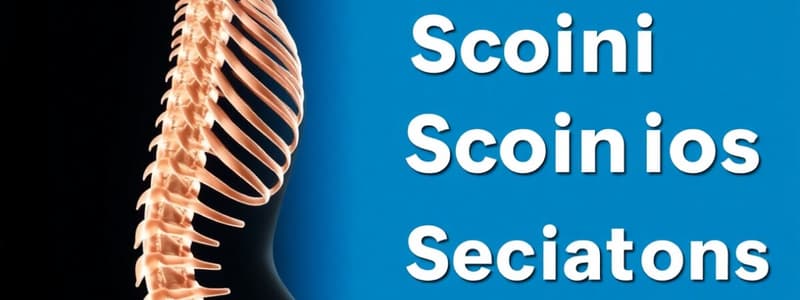Podcast
Questions and Answers
Scoliosis is identified when the Cobb angle is greater than 20 degrees.
Scoliosis is identified when the Cobb angle is greater than 20 degrees.
False (B)
In juvenile scoliosis, the curvature is typically left side convex.
In juvenile scoliosis, the curvature is typically left side convex.
False (B)
Adolescent scoliosis is more common in males than females.
Adolescent scoliosis is more common in males than females.
False (B)
If the Cobb angle at skeletal maturity exceeds 30 degrees, adolescent scoliosis is likely to progress.
If the Cobb angle at skeletal maturity exceeds 30 degrees, adolescent scoliosis is likely to progress.
Scoliosis usually regresses in juvenile cases regardless of any treatment.
Scoliosis usually regresses in juvenile cases regardless of any treatment.
Flashcards
What is Infantile Scoliosis?
What is Infantile Scoliosis?
A sideways curve in the spine (greater than 10 degrees) that appears on an X-ray. The curve is to the left and usually disappears.
What is Juvenile Scoliosis?
What is Juvenile Scoliosis?
A sideways curve in the spine (greater than 10 degrees) that appears on an X-ray. The curve is to the right and more likely to worsen. .
What is Adolescent Scoliosis?
What is Adolescent Scoliosis?
A sideways curve in the spine (greater than 10 degrees) that appears on an X-ray. The curve is to the right and often involves the upper back. It's more likely to worsen if the curve is more than 30 degrees at skeletal maturity.
What is the Cobb angle?
What is the Cobb angle?
Signup and view all the flashcards
What is Skeletal Maturity?
What is Skeletal Maturity?
Signup and view all the flashcards
Study Notes
Scoliosis Definition
- Scoliosis is a lateral curvature of the spine, visible on a posterior-anterior (PA) X-ray, with a Cobb angle exceeding 10 degrees.
Types and Characteristics
-
Juvenile Scoliosis:
- Occurs in children aged 4-9 years old.
- More common in girls.
- Characterized by a right-sided curvature.
- Usually resolves (regresses) over time.
-
Adolescent Scoliosis:
- Typically affects adolescents, particularly females.
- Often features a right-sided thoracic curvature (in the upper back).
- Progression depends on the Cobb angle at skeletal maturity.
- If the Cobb angle exceeds 30 degrees at skeletal maturity, the condition is typically progressive.
Studying That Suits You
Use AI to generate personalized quizzes and flashcards to suit your learning preferences.
Description
Explore the definition and types of scoliosis, including juvenile and adolescent forms. Learn about characteristics, progression, and the significance of the Cobb angle. This quiz is designed to test your knowledge on scoliosis and its implications.




